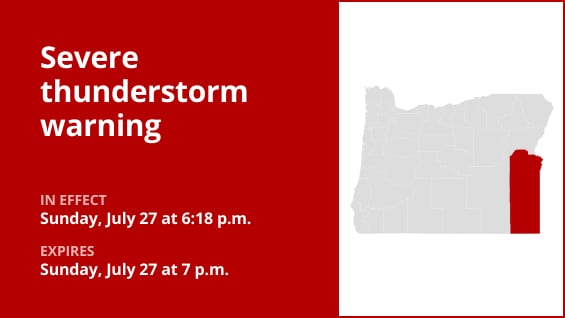The National Weather Service declared a severe thunderstorm warning for Malheur County at 6:18 p.m. on Sunday, which would last until 7 p.m.
Walnut-sized hail (1.5 inches) and wind gusts of up to 60 mph are features of the storms.
“At 6:17 p.m., a severe thunderstorm was located near Pelican Point, or 28 miles southwest of Parma, moving north at 15 mph,” according to the meteorological service. “Outdoor animals and people will sustain injuries. Anticipate hail damage to cars, windows, siding, and roofs. Expect trees, siding, and roofs to sustain wind damage.
Be advised that about 6:30 p.m., Board Corral Mountain may be affected by the thunderstorm.
“Move to an interior room on the lowest floor of a building for your protection,” the weather service advises. This storm is causing large hail, destructive winds, and persistent lightning from clouds to the earth. Go inside right now. One of nature’s greatest murderers is lightning. Keep in mind that lightning can strike you if you can hear thunder. Avoid the water and seek shelter indoors or in a car if you are on or near Owyhee Reservoir. Keep in mind that lightning can occur up to 15 miles away from the main thunderstorm. You are close enough to be hit by lightning if you can hear thunder. Now get into a safe place! Avoid being stranded on the water during a thunderstorm. This storm is causing torrential rains, which could cause flash floods. Avoid operating a car on flooded roads. Please use local law enforcement or the National Weather Service Boise’s Facebook and Twitter pages to report storms to the local weather service when it’s safe to do so.
Preparing for impending lightning strikes: Expert safety recommendations
Approximately 25 million lightning strikes occur in the United States annually, most of which take place in the summer. The weather service reports that lightning is the cause of death for about 20 persons each year. As thunderstorms get closer, the risk of lightning increases; it peaks when the storm is directly overhead and then progressively decreases as it passes.
Remember the following advice to stay safe during a thunderstorm:
Plan for lightning safety:
-
When venturing outdoors, it’s vital to establish a clear plan for seeking shelter in case of lightning.
-
Stay vigilant by monitoring the sky for ominous signs and listening for the telltale sound of thunder. If thunder is audible, it’s a clear indication of nearby lightning.
-
Seek a safe place to shelter, preferably indoors.
Indoor safety precautions:
-
Once you’re indoors, avoid using corded phones, electrical devices, plumbing fixtures, and stay away from windows and doors.
-
These precautions help reduce the risk of electrical surges, as lightning can follow conductive pathways.
Hold off till the all-clear:
-
After the last lightning strike or thunderclap, wait at least 30 minutes before resuming outdoor activities.
-
It’s important to remember that lightning can strike even when a storm seems to have passed, so exercise caution.
When there is no indoor shelter:
Take these precautions to increase your safety if you are outside during a thunderstorm without access to indoor shelter:
-
Avoid open fields, hilltops, or ridge crests, as they expose you to greater lightning risk.
-
Steer clear of tall, isolated trees and other prominent objects. In forested areas, stay close to lower stands of trees.
-
If you’re with a group, ensure individuals are spread out to prevent lightning current from transferring between people.
-
Camping in an open setting during a thunderstorm is strongly discouraged. If you have no alternative, set up camp in a valley, ravine, or other low-lying areas. It’s crucial to note that a tent provides no protection against lightning.
-
Do not approach water bodies, wet objects, or metal items. Although water and metal do not attract lightning, they conduct electricity effectively and can pose significant risks.
In conclusion, readiness and alertness are your greatest allies while dealing with the threat of lightning. You may put your safety first and drastically lower the chance of lightning-related mishaps by adhering to these rules.
Mastering wet roads: Safety tips for heavy rainfall
There is a greater chance of floods and dangerous roadways when it rains a lot. The weather service has provided the following advice to help you keep safe during downpours:
Watch out for swift water flow:
Avoid parking or strolling close to drainage ditches or culverts during periods of intense rain, since the swift-moving water can be quite dangerous.
Keep your distances from other vehicles safe:
Keep a safe distance from the automobile ahead of you by following the two-second rule, and give yourself an extra two seconds if it’s raining a lot.
Reduce your speed and drive carefully:
Lowering your speed is essential on wet roads. To prevent skidding, gently release the gas pedal and refrain from applying sudden braking.
Pick your lane carefully:
Water tends to pool in the outside lanes, so stick to the central ones.
Visibility is important.
As rain-spattered windows make it more difficult to see other vehicles, turn on your headlights and pay attention to those in blind spots and behind you.
Be cautious on slick roads:
Because of a combination of rain, oil, and grime, roadways are at their slickest during the first 30 minutes of precipitation. Be especially careful during this time.
Stay a safe distance away from big cars:
Tire spray from big vehicles and buses can make it harder to see. Pass them quickly and safely, and refrain from tailgating.
Be mindful of your wipers:
Visibility may be hampered by overloaded wiper blades. If the rain makes it very difficult to see, stop and wait for the weather to clear up. Look for cover in covered areas or rest areas.
Position your car as far off the road as you can, preferably beyond guardrails, if stopping by the side of the road is your only choice. To let other cars know where you are, turn on your emergency flashers and keep your headlights on.
You may greatly lower dangers and protect your health when it rains a lot by adhering to these safety precautions. To ensure a safe and sound voyage, keep yourself updated on weather conditions and follow local authorities’ instructions.
United Robots offers a service called Advance Local Weather Alerts that gathers the most recent information from the National Weather Service using machine learning.





More Stories
Brace for damaging winds and walnut-sized hail with thunderstorms in Malheur County Sunday
Brace for damaging winds and walnut-sized hail with thunderstorms in Malheur County Sunday
Brace for damaging winds and walnut-sized hail with thunderstorms in Malheur County Sunday